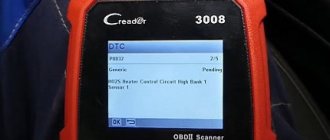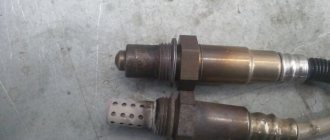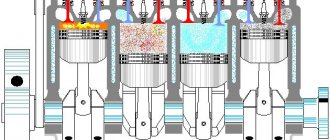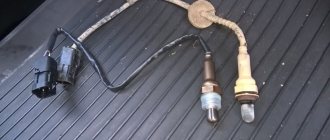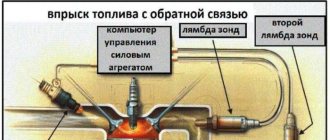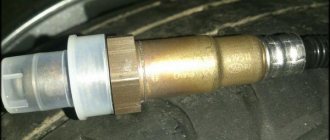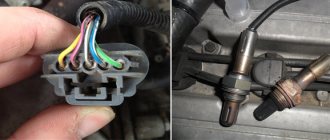Reasons for error P0141
There are not many possible reasons that could signal the controller to set error code p0141:
- Loss of contact in the lambda probe power supply;
- Fume of the oxygen sensor heating coil;
- Installing a different type of sensor.
Therefore, if the goal is to get rid of the annoying light on the dashboard that reminds you of a problem with the oxygen sensor after the catalyst, then you should start looking for the problem by checking the condition of the contacts and wiring of the sensor.
The ECU checks the oxygen sensor heater circuit upon first start-up and detects an open or short circuit or increased current consumption in the lambda probe heater circuit.
How does a car behave with error P0130?
Error P0130, indicating problems with the voltage in the oxygen sensor circuit, directly affects engine performance. The most noticeable consequences of its occurrence are at high speeds of a car engine. The driver can expect the following troubles:
- Increased fuel consumption;
- Unstable engine operation at high speeds;
- Loss in dynamics - the car will begin to accelerate more slowly, and even with increased pressure on the gas pedal, the situation will not change.
Most often, the consequences of the P0130 error do not appear immediately.
It is important to note that driving a vehicle diagnosed with P0130 is extremely dangerous in terms of increasing the likelihood of failure of expensive engine components.
Symptoms of malfunction
Since there are one or two reasons, many do not even try to check the lambda probe, but immediately change it at the slightest suspicion of losing its functions (especially at a service station), but if you are doing it for yourself, then, of course, it’s worth checking and inspect the contacts, pay attention to all signs of malfunction of the lambda probe.
You will need an inspection hole, since the oxygen sensor is located behind the catalyst, and remove the power connector from it. Surely it will be completely covered with greenish oxide. Also look at the wires coming from the connector, because there is a possibility that one of the wires is broken or shorted.
To make a correct verdict about the serviceability of the oxygen sensor, it is very important to know the nominal resistance of the sensor heating, since at a temperature of 20 °C it is lower when the engine is warm, when the exhaust temperature is higher than 800 °C. Depending on the make of the car and the type of sensor, this resistance differs.
DETAILS: Speed sensor
If the check shows that the lambda is out of order, then we replace the sensor with a new one, there is also a nuance here, because car owners often, not finding a similar sensor, install a universal one or from another car, which may not always be suitable.
When replacing oxygen sensors, be sure to remove the terminal from the battery!
When the check, on the contrary, showed that the lambda probe is in perfect health and is ready to continue to serve, then firstly you need to delete the error from the ECU memory and, if it occurs again, diagnose it again, because the reason for setting the fault code can be a number of related codes, even a malfunction ECU.
This error may be accompanied by the following symptoms:
- Unstable engine operation with misfires;
- illuminated Check Engine indicator on the instrument panel;
- increased fuel consumption.
In order to save money and accurately establish the “diagnosis”, follow these simple tips:
- Check the wiring and sensor connector for moisture, which may cause a short circuit.
- Check the lambda probe for oil or coolant contamination.
- After installing the new oxygen sensor, check it with a scan tool to ensure that the heater circuit is working properly.
- Check the old lambda probe for damage caused by a faulty catalytic converter.
How is error P0130 diagnosed?
For P0130 to be stored in the vehicle's ECU, the oxygen sensor must be faulty for 1 minute or more. If no data is received from the sensor (or it is erroneous, for example, the lambda probe slowly changes values) for a minute, then error information P0130 is stored in memory.
It is worth noting that if the oxygen sensor fails and no signal is received from it, error P0134 can be diagnosed along with error P0130.
Lambda probe on VAZ cars
VAZs use several types of sensors:
1. Bosch No. 0 258 005 133, Euro standard - 2. Installed on outdated models with an engine capacity of 1.5 liters. On later models with Euro 3 standard, this sensor was used as the first one, and was installed before the catalyst.
The second sensor was installed, which has a “return connector”. But you can find two identical sensors installed
2. Bosch No. 0 258 006537 was installed on cars manufactured since October 2004. They have a heating element in their structure.
Lambda probes produced are interchangeable with zirconium sensors of similar structure. Please note that a non-heated sensor can be replaced with a heated sensor. Not the other way around.
Diagnosing Error Code P0141
To find the exact cause of the error, you must perform the following steps:
- Check the electrical connectors and insulation of the wiring leading to oxygen sensor No. 2 (after the catalyst).
- Check the lambda probe readings using a scanner to see if the sensor heating circuit is working.
- Check that there is power to the oxygen sensor heater.
- Check the heating resistance of the lambda probe to ensure it meets the manufacturer's specifications.
DETAILS: Why Car Windows Sweat, Reasons and 10 Answers on What to Do
Eliminating an error in the heating circuit
First, we make sure that the sensor wiring is intact, and then we check the condition of the contact chip (we clean the oxidation). After which it would be logical to check the resistance of the lambda heating. On a warm engine, at a normal temperature of 20 °C, we remove the chip from the sensor and measure the resistance between two wires of the same color (they are supplied with 12V power).
Having done all of the above, cleaned the contacts or replaced the sensor, error P0135 should disappear after a few minutes of engine operation. Having a computer at hand with a special program installed, you can check this and delete the event recorded in the archive. You can also reset the error by removing the terminal from the battery.
What to do if error P0130 occurs
As you can understand from the description of the problem, there are not many factors that lead to error P0130. Accordingly, the driver or technician can get rid of the malfunction by performing the following algorithm of actions to determine the cause of the problem and eliminate it:
- The first step is to check the wires that supply the first lambda probe (installed before the catalyst);
- If power is supplied through the wires, carefully inspect the oxygen sensor connector for corrosion, damage, carbon deposits, contamination and other defects;
- Next, it is recommended to check the voltage between the lambda probe signal wire and ground. To do this, you need to connect the voltmeter probes to them. If the oxygen sensor is working properly, its voltage will be around 0.45 Volts (if the voltmeter shows a different number, it is recommended to check the voltage value for your specific car model, as it may differ);
- It is also recommended to use an ohmmeter to check the resistance of the oxygen sensor heater (two white wires). The resistance value will vary from 2 to 10 ohms, depending on the car model. The exact value can be found in the documentation for the sensor;
- If the problem is not related to the wiring and oxygen sensor, you need to check the mass air flow sensor and the tightness of the exhaust manifold; the gaskets may need to be replaced. Be sure to diagnose the presence of suction in the circuit after the flow meter.
After completing the necessary steps to eliminate the P0130 error, you should let the engine run for some time in various modes (especially those in which the Check Engine light came on) and reset the error.
Most often, error P0130 is diagnosed on Opel, Kia, Hyundai, Subaru and Ford vehicles.
Diagnosis of the problem
The most common problem that causes P0135 on vehicles with a low oxygen sensor is a physical break in the wire. You don’t have to be into off-road driving to do this: you can damage the wiring even in an off-road parking lot if you’re unlucky. Therefore, first of all, inspect both the sensor wiring and its connector. We are specifically interested in the heating wires, which can be found in the service documentation for your car or, in the case of common Bosch sensors, immediately look at the two white wires.
Something else useful for you:
- Why does the engine start poorly when cold?
- Fuel pressure regulator - device, principle of operation, malfunctions
- Why does the speed fluctuate on a cold engine?
If there are no visible signs of a break or oxidation of the wiring (do not forget that an excessive increase in circuit resistance will also lead to error P0135!), measure the resistance of the heater with a tester. Depending on the model of a particular lambda probe, it varies, but in any case it will be in the range of 3-20 Ohms.
If the measured value differs by an order of magnitude, or the tester shows a complete break, the sensor must be replaced. Usually the ceramic heating element fails due to cracking (often a rustling sound is heard in the removed sensor when shaken), but in any case it is not repairable.
This is interesting: Support bearing - what is it
But, if the resistance of the heater itself is normal, the problem lies in the external circuits. Having turned on the ignition, we use a tester to check the contacts on the “braid” connector. On one of them, the voltage differs slightly from the on-board voltage, the second is called to ground (the heating control key is open, the resistance of the open key is tenths or hundredths of an ohm).
The biggest problem is the failure of the key itself in the control unit, which is rare, but even in diagnostic practice one has to deal with it. In this case, the most profitable option for the owner, even for domestic cars, is to resolder the block rather than replace it with a new one. To check the serviceability of the key, use a tester to test the entire circuit from the lambda probe connector to the injection computer connector. If the circuit is working properly, it is the block that is “to blame”.
Signs of error P0135
Even before diagnosing the P0135 error, the following symptoms may indicate its possible presence:
- complicated engine starting, especially in the cold season, wet weather;
- change in the nature of exhaust gases (grayish-black tint);
- slightly increased fuel consumption per unit of travel.
The listed symptoms may be the result of other malfunctions, therefore, to accurately determine the type of error, computer diagnostics of the engine should be performed.
How can I fix error 0141
Methods to combat the problem are as follows:
- delete the stored fault codes from the control unit’s memory and carry out a road test to check (the error may have appeared only once);
- replace the oxygen sensor;
- repair or replace the sensor wiring or connector;
- Replace the fuse in the lambda probe heating circuit.
DETAILS: Tips on how to start a car in severe frost
Additional recommendations
Error P0141 can only be caused by a malfunction in the heating circuit of the oxygen sensor 2 installed after the catalyst. This sensor and fault code are in no way related to the first lambda probe.
Oxygen sensors send information to the electronic engine control unit, which uses it to properly control the operation of the fuel injectors. If you disconnect one of these sensors or both lambda probes, the ECU will operate in emergency mode, which will lead to a significant increase in fuel consumption.
Note that errors related to oxygen sensors can sometimes be caused by malfunctions of other engine components. Therefore, do not rush to change the sensor immediately. Engine diagnostics must be carried out comprehensively. There are cases that the problem lies even in the failure of the control unit.
- Trouble P0135 - Oxygen Sensor Heater Circuit Malfunction
- Error P0157 - Oxygen Sensor Circuit Low Voltage
- P0113 engine intake air temperature sensor failure IAT sensor error code p0113
- P2135 error of throttle position sensors Code p2135 indicates a mismatch between the readings of sensors 1 and 2 on the remote control
Is it possible to drive with P0135?
Older injection systems initially retain a “wait” for warming up, that is, in the worst case, fuel consumption will slightly increase (due to the fact that reaching the “closed loop” during warming up will begin to lag). Many cars easily drive several thousand until the owner gets tired of the Check Engine light being on.
This is interesting: High input voltage of the IAT sensor - error P0113 VAZ
In the future, this emergency algorithm was preserved, the only “but” in the larger “choke” under strict economic standards. That is, a modern car will not experience serious problems with faulty heating if the sensor itself is working properly.
However, if the error occurs randomly (that is, after a reset, not immediately after turning on the ignition, when the self-test is running, but with a random delay or even while driving), then this indicates more serious problems. Thus, there are known cases when, to eliminate error P0135, dealers replaced defective wiring harnesses on Kia Ceed. If the error occurs due to a bad contact on the ECU connector, then it is unlikely that the problem is only in one contact out of several dozen (or even more than a hundred), there may be further “surprises”.
Therefore, the answer is simple: you can drive with a faulty heated upstream oxygen sensor. But with error P0135 without establishing the exact cause of its occurrence, it is extremely undesirable.
